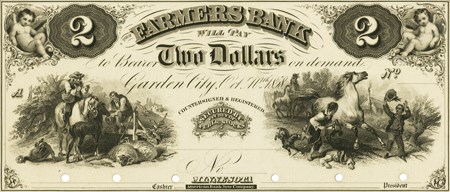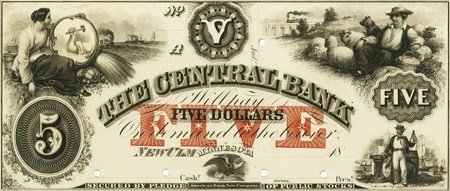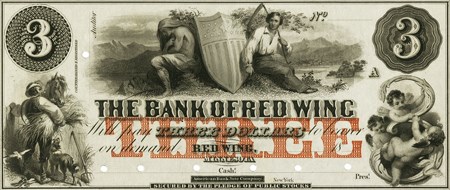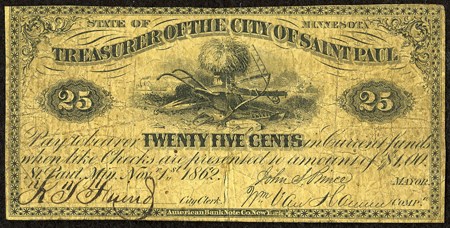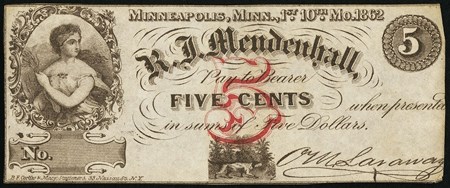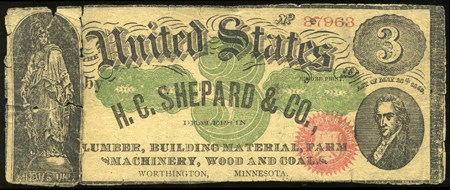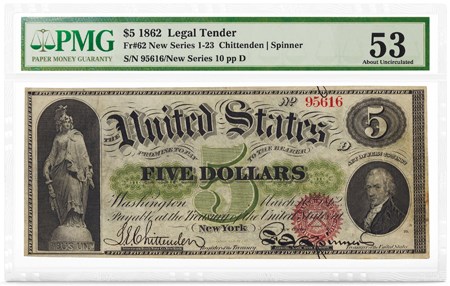History of Minnesota Paper Money
Posted on 4/19/2016
Continuing with our state-by-state analysis of obsolete currency, today I’d like to discuss Minnesotan paper money. Minnesota was admitted into the Union on May 11, 1858, becoming the 32nd state. Since its incorporation into the United States, Minnesota has had a rich history of paper money in the form of obsolete and scrip notes. Before becoming a state, the Territory of Minnesota was created in 1849. However, the area had been inhabited for quite some time before this. European settlers, particularly Scandinavian and German, and Native Americans had occupied the area since the 1600s. The significant presence of these groups is often reflected in the designs of Minnesotan banknotes.
Minnesota State Bank Notes
After becoming a state, the Minnesota legislature created banking laws to replace its “free banking” era laws. The laws set up state banks and required them to have at least $25,000 in capital and could not exist in towns with less than two hundred inhabitants among other regulations. The law also approved the distribution of paper money. The state auditor was responsible for “printing, accounting for, countersigning and issuing notes to individual banks.” The banks were backed by railroad bonds and most did not last more than a few years. With the establishment of a federal currency system, the state banknotes fell out of favor for the new federal banknotes and eventually the state banking laws were amended to fall in line with the federal system. Below are examples of banknotes from state banks in Minnesota.
St. Paul-Minneapolis Currency
Upon its creation, the Territory of Minnesota had three cities: St. Paul, Minneapolis and Stillwater. St. Paul and Minneapolis were the largest of the three with St. Paul becoming the state capital. The two cities are close enough together that they were eventually called the “Twin Cities.” The populations of these cities resulted in many private banks and companies springing up and printing their own currency. This happened in concurrence with the local government printing their own paper money. Below are some examples of currency from the St. Paul-Minneapolis area.
Advertising Scrip
While some private companies released currency that could only be used at their store, others found different ways to drum up business. One of these ways was to print advertisements that looked like banknotes. These advertising notes were common across all of the United States. Oftentimes these advertising notes would look very similar to US or Confederate banknotes. They would use the same designs, often crudely drawn, but have different text on them promoting whatever business that issued them. Below is an example of a private business copying the design of the $3 legal tender note from the 1860s. There’s also an example of a genuine $5 just to show how closely they resemble each other.
There are hundreds of other examples of banknotes from Minnesota. The wide variety provides numismatists from this state and others an entertaining challenge to build the best collection of notes from the North Star State. For help finding more information on the more obscure Minnesotan notes, check out A History and Catalogue of Minnesota Obsolete Bank Notes & Scrip by R. Shawn Hewitt. Stay tuned for the next addition in our state-by-state analysis of obsolete paper money when we dive into Paper Money Guaranty’s home state of Florida.
Source:
- Hewitt, R. S. (2006). A History and Catalogue of Minnesota Obsolete Bank Notes & Scrip. R. M. Smythe & Co.
Stay Informed
Want news like this delivered to your inbox once a month? Subscribe to the free PMG eNewsletter today!
